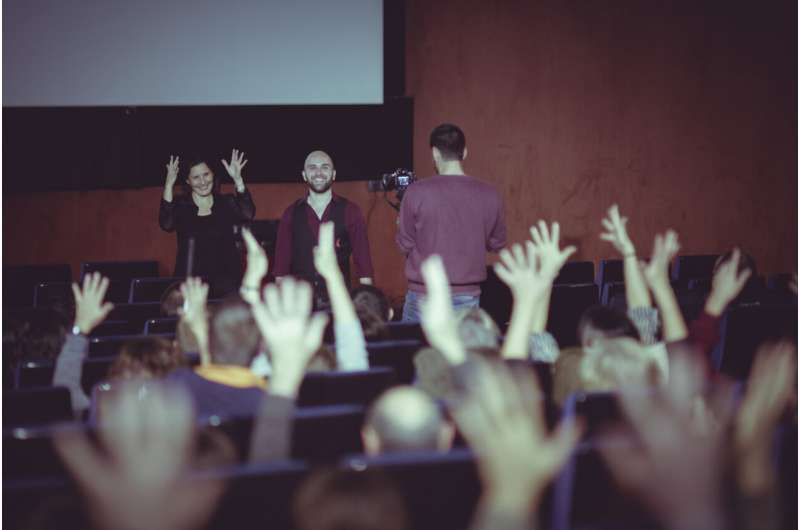This article has been reviewed according to Science X's editorial process and policies. Editors have highlighted the following attributes while ensuring the content's credibility:
fact-checked
proofread
Film director explains how to make inclusive cinema to favor access for people with disabilities

The film director Miguel Ángel Font Bisier, a student on the Ph.D. program in Applied Languages, Literature and Translation, has defended an innovative thesis at the Universitat Jaume I in Castellón titled "Inclusive cinema: Context, methodology and praxis" directed by Irene de Higes Andino, researcher of the TRAMA group and lecturer in the Department of Translation and Communication, in which she explores the concept of inclusive cinema, a modality of audiovisual production that favors the participation and access of people with disabilities to the cinematographic medium from the script of each production.
The work is published in the Ética y Cine Journal.
Inclusive cinema is the creation of works that are in line with current regulations, coherent with the film production system and respectful of people with disabilities. From the script of each project, invisible but perceptible resources are added for this audience and there is collaboration with people with disabilities (from the script to distribution).
Furthermore, special care is taken in the creation of audio description, accessible subtitling and other accessibility tools thanks to the interaction of the creative team with the accessibility teams, who are hired from pre-production and have at their disposal the so-called "accessibility report."
This report, explained in the thesis, allows the accessibility team to have a template of information about all the departments involved in the audiovisual product and helps to prepare a more faithful accessibility to the thematic axes and the deep message of the audiovisual work, which does not have to be deduced from the final product without contact with the creative team, as it happens in the traditional model of creation and distribution.
The work is based on a double methodology, an action-research and a qualitative case study, which reviews the background, characteristics, objectives and practical applications of inclusive cinema through the analysis of several national and international success stories. The author also proposes his own paradigm for the development of inclusive film projects based on the principles of universal design.
During the writing of the research work, specifically during the previous research-action process, the Ph.D. student had the participation of entities and associations such as CERMI, COCEMFE, FESORD, ASOCIDE or ONCE, which helped to outline the inclusive cinema proposal.
Dr. Miguel Ángel Font Bisier is a renowned film director who has made numerous short films and documentaries with an inclusive approach, such as XMILE, Tiempo de blues or Creando cine inclusivo. His work has received numerous awards and has been screened at more than 200 national and international festivals.
At the Universitat Jaume I, teaching and research on accessibility in the audiovisual environment dates back two decades, when the Translation for Audiovisual Media and Accessibility (TRAMA) group, coordinated by Professor Frederic Chaume Valera, began its work, with the introduction of this field in Translation and Interpreting studies and projects that investigated how to integrate accessibility in audiovisual translation from the outset.
One of the most outstanding projects was the ITACA project (Social Inclusion, Audiovisual Translation and Audiovisual Communication), in which specific solutions were proposed to improve the level of accessibility of audiovisual works for people with sensory limitations (deafness and blindness). It revolved around the concept of accessible audiovisual production with the aim of integrating it as part of the process and facilitating collaboration between audiovisual production and translation professionals.
Among the results of the project is the concept of inclusive scriptwriting, which was brought to the classroom through two educational innovation projects in 2020 and 2021, where students of Translation and Interpreting collaborated with students of Audiovisual Communication and Video Game Design and Development to create inclusive news, and also a database that collects information on films that have been produced in an inclusive way.
Although the project worked especially on the news, contact with professionals in the sector led them to learn about the work of Miguel Ángel Font Bisier, a director who since 2016 has been producing audiovisual works that increasingly integrate accessibility, which has allowed him to develop a model of audiovisual creation and distribution: inclusive cinema.
More information: Miguel Angel Font Bisier, Análisis de la norma UNE 153020 sobre audiodescripción, Ética y Cine Journal (2023). DOI: 10.31056/2250.5415.v13.n1.40640
Provided by Universitat Jaume I





















